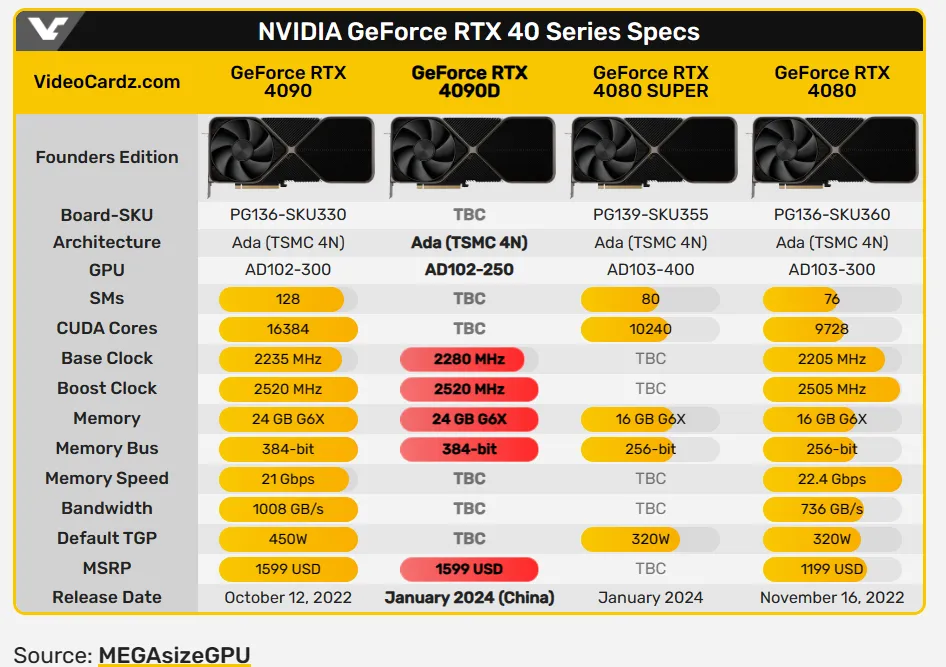In a strategic market maneuver, Nvidia has unveiled the RTX 4090D—a slightly less potent iteration of its high-performance RTX 4090 GPU—specifically for the Chinese market. This move directly responds to the U.S. government’s efforts to hurt the Chinese tech market by restricting the exports of advanced goods and services from American providers amid escalating geopolitical tensions.
At the core of the new regulations? A desire to stymie Chinese efforts to achieve dominance in artificial intelligence tech.
The recently revealed RTX 4090D features 14,592 CUDA processing cores, compared to 16,384 in the standard RTX 4090. It also has a slightly lower power draw at 425W instead of 450W. As a result, the 4090D is just 5% less powerful than the original, but still manages to respect the 4,800 TOPS (trillion operations per second) speed limit established by the United States as the fastest that American hardware can achieve and still be sold in China.
Also, the new GPUs won’t support overclocking, so (at least on paper) there is no way to tweak them to make them more powerful.

The release of the 4090D comes after the U.S. added the flagship RTX 4090 gaming GPU to its list of banned exports to China in October.
“The GeForce RTX 4090D has been designed to fully comply with U.S. government export controls,” an Nvidia spokesman stated in an email to The Verge, noting that Nvidia “extensively engaged with the U.S. government” during development.
The U.S. has been increasingly strict about banning the export of advanced AI accelerators and other high-performance chips to China. Commerce Secretary Gina Raimondo recently warned chipmakers about attempts to work around these sanctions, stating at the Reagan National Defense Forum that “if you redesign a chip around a particular cut line that enables them to do AI, I’m going to control it the very next day.”
This warning seemed aimed at Nvidia’s efforts to do just that—developing compliant chips after its existing products were banned. For example, when the U.S. prohibited exports of Nvidia’s H100 and A100 AI accelerators in August, the company launched the A800 for China in November—an essentially identical chip to the A100 but with reduced interconnect bandwidth.
“I know there are CEOs of chip companies in this audience who were a little cranky with me when I did that because you’re losing revenue,” Raimondo said. “Such is life. Protecting our national security matters more than short-term revenue.”
The launch of the RTX 4090D represents Nvidia’s latest attempt to comply with U.S. sanctions while still serving customers in China, one of its major markets. With its reduced tensor cores and lower power consumption, the 4090D seems carefully crafted to avoid crossing the U.S. government’s red lines on supporting advanced AI development in China, but it is still powerful enough to perform well in games and even in AI training if properly configured.
Chinese businesses have been preparing to confront America’s sanctions. Some of the most important tech giants in China—such as Baidu, ByteDance, Tencent and Alibaba—snapped up to $5 billion in Nvidia hardware just before Raimondo’s actions took place—a move replicated by smaller businesses.
However, as Secretary Raimondo’s warnings indicate, the U.S. will likely continue monitoring and restricting any Nvidia products that could potentially enable AI acceleration. Despite this delicate dance around emerging technology exports between the two superpowers, enthusiasts can at least run their PC games in max configurations.
Edited by Ryan Ozawa.
Stay on top of crypto news, get daily updates in your inbox.
- SEO Powered Content & PR Distribution. Get Amplified Today.
- PlatoData.Network Vertical Generative Ai. Empower Yourself. Access Here.
- PlatoAiStream. Web3 Intelligence. Knowledge Amplified. Access Here.
- PlatoESG. Carbon, CleanTech, Energy, Environment, Solar, Waste Management. Access Here.
- PlatoHealth. Biotech and Clinical Trials Intelligence. Access Here.
- Source: https://decrypt.co/211222/nvidia-rtx-4090d-gpu-chinese-market



